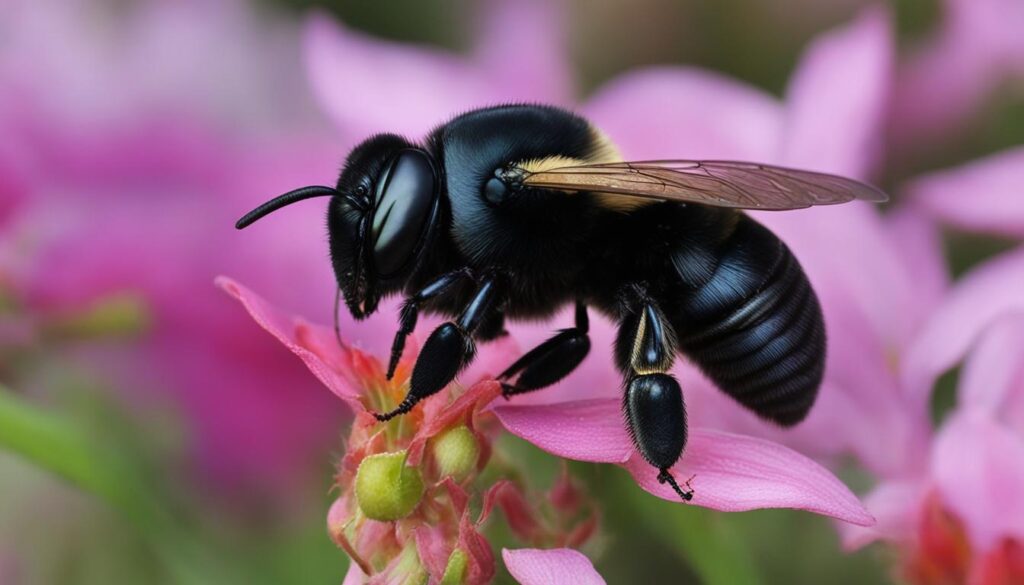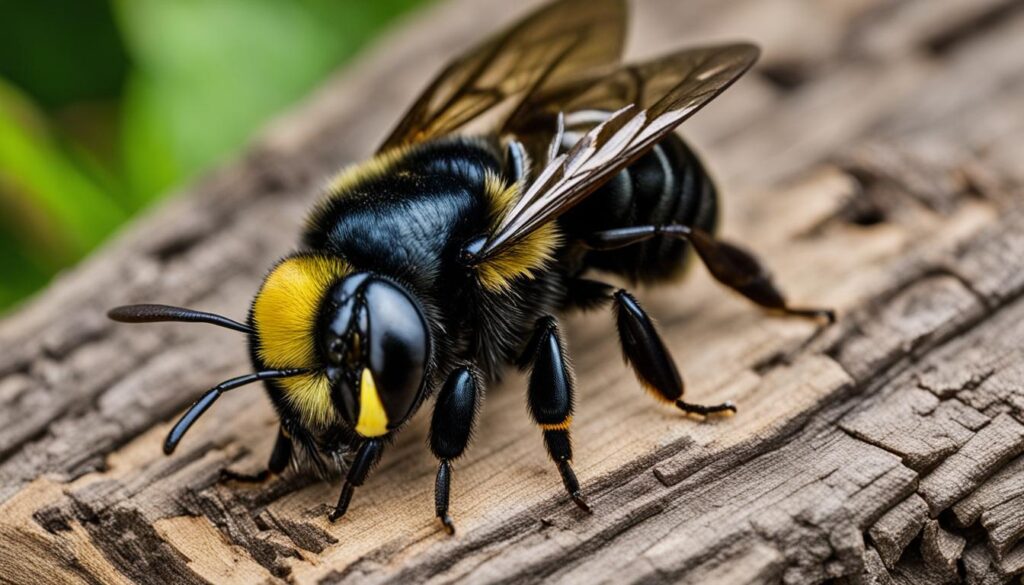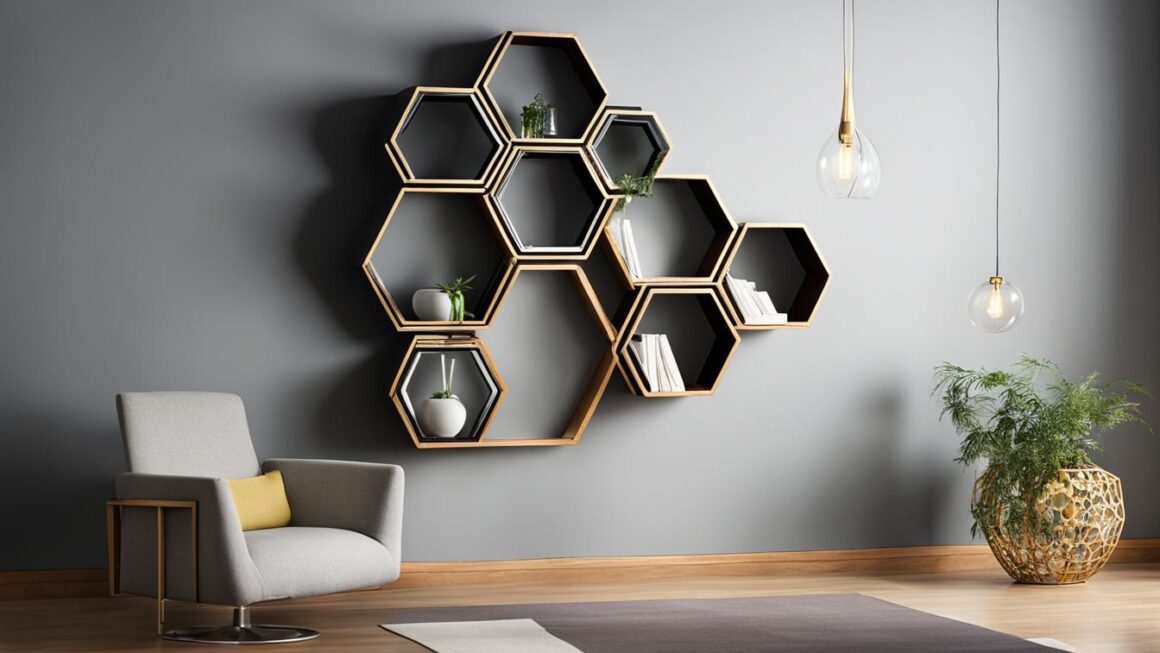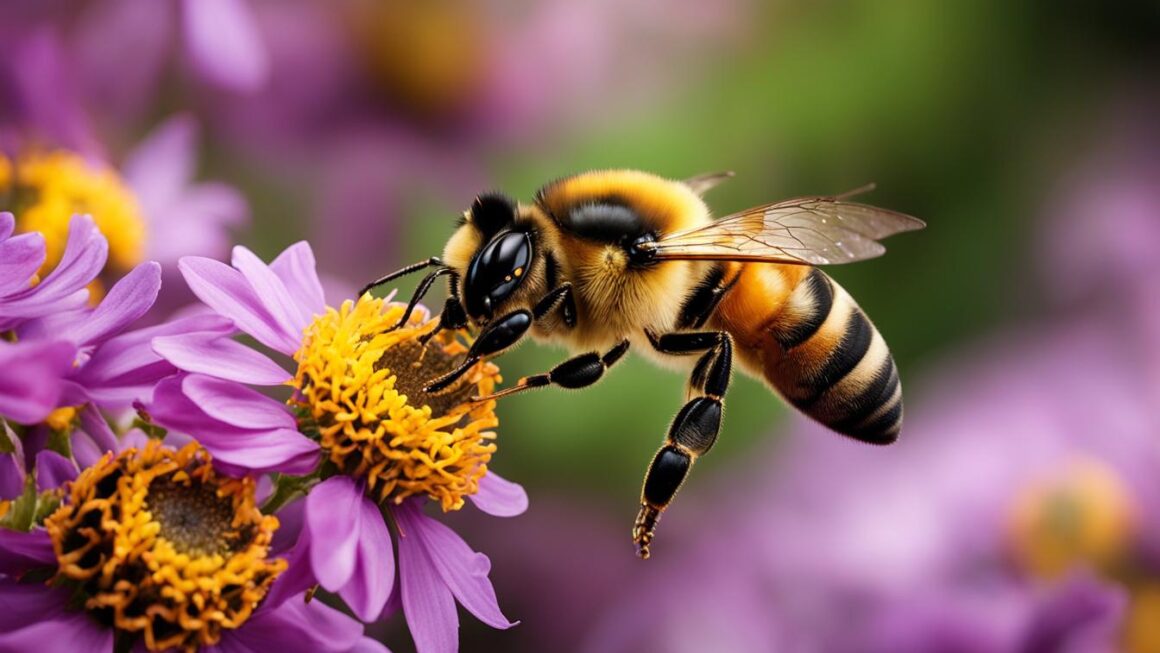Are you wondering if carpenter bees can bite? While carpenter bees are capable of biting humans, it is not their primary defense mechanism. Female carpenter bees have stingers and can sting if they feel threatened or provoked. However, they are not aggressive by nature and are unlikely to sting unless provoked. Male carpenter bees, on the other hand, do not have stingers and are unable to bite or sting.
Key Takeaways:
- Carpenter bees are capable of biting humans, but it is not their primary defense mechanism.
- Female carpenter bees have stingers and can sting if they feel threatened or provoked.
- Male carpenter bees do not have stingers and are unable to bite or sting.
- Carpenter bees are not aggressive by nature and are unlikely to sting unless provoked.
- Preventive measures can reduce the risk of carpenter bee bites.
What Are Carpenter Bees?
Carpenter bees are a type of solitary bee that are commonly found nesting in wood. They are often mistaken for bumblebees due to their similar size and appearance. Carpenter bees burrow into wood to create their nests, leaving behind round entrance holes and piles of sawdust. While they do not eat wood, they rely on wood for nesting purposes. If left untreated, a carpenter bee infestation can lead to structural damage over time.
To better understand carpenter bee behavior, let’s take a closer look at their nesting habits. Female carpenter bees are responsible for tunneling into wood to create individual galleries where they lay their eggs and provide food for their larvae. These galleries can extend several inches into the wood, resulting in weakened structures. Male carpenter bees hover around the nest entrances, guarding them from potential threats. It is important to note that carpenter bees prefer untreated wood, making wooden structures, such as decks, fences, and eaves, vulnerable to infestation.
“Carpenter bees burrow into wood to create their nests, leaving behind round entrance holes and piles of sawdust.”
Identifying carpenter bee infestations is crucial in preventing further damage. Look for round entrance holes with smooth edges on wooden surfaces and piles of sawdust, which are known as “frass.” These signs indicate the presence of carpenter bees. Additionally, paying attention to buzzing sounds around wooden structures can help detect their activity. Taking prompt action to address carpenter bee infestations is essential to avoid extensive damage to the wood and potential harm to the surrounding area.
Table: Comparison of Carpenter Bees and Bumblebees
| Characteristic | Carpenter Bees | Bumblebees |
|---|---|---|
| Size | Approximately 1 inch | Varies, but generally larger than carpenter bees |
| Abdomen | Smooth, shiny black | Fuzzy, usually yellow and black |
| Behavior | Burrow into wood to nest | Nest in underground burrows or grassy areas |
Understanding carpenter bee behavior is crucial in effectively managing and preventing infestations. By recognizing their nesting habits and signs of activity, homeowners can take proactive measures to protect their wooden structures and minimize potential damage.
Carpenter Bee Characteristics
Carpenter bees are a unique species of solitary bees known for their fascinating characteristics. Understanding their behavior and traits is crucial for effective carpenter bee removal and prevention strategies.
Appearance
Carpenter bees are typically around 1 inch in length and can have varying color patterns. Some species are solid black, while others have a combination of black and yellow markings. One key distinguishing feature of carpenter bees is their hairless, shiny black abdomen, which sets them apart from bumblebees with their fuzzy abdomens.
Behavior
Carpenter bees exhibit different behaviors depending on their gender. Female carpenter bees are responsible for tunneling into wood to create nests for their offspring. They chew perfect circular holes into wood surfaces, leaving behind telltale signs of their presence. Male carpenter bees, meanwhile, hover around the nest entrances, guarding them from potential threats.
Similar to other bees, carpenter bees collect nectar and pollen for their young. They play a vital role in pollination by transferring pollen from one plant to another, promoting plant reproduction and supporting ecosystem health.
Understanding the characteristics and behavior of carpenter bees is essential for effective removal, prevention, and the preservation of wooden structures.
Are Carpenter Bees Pollinators?
Yes, carpenter bees are considered important pollinators. They play a vital role in the pollination of various plants, contributing to plant reproduction and the health of ecosystems. Carpenter bees gather pollen and nectar for their larvae, aiding in the cross-pollination of flowers and crops.
Unlike social bees that live in colonies, carpenter bees are solitary insects. They do not have a hive or produce honey. Instead, they create individual galleries in wood by chewing circular holes. Female carpenter bees tunnel into wood to lay their eggs and provide food for their offspring. As they collect pollen and nectar, they inadvertently transfer pollen from one flower to another, facilitating the fertilization process.
The role of carpenter bees in pollination is especially beneficial for certain crops, such as eggplants and tomatoes. These crops rely on buzz pollination, a specific technique where the bee vibrates its flight muscles to dislodge pollen from the flower’s anthers. Carpenter bees, with their vibrating flight patterns, are particularly effective at buzz pollination, making them valuable pollinators for these types of plants.
Overall, carpenter bees play a crucial role in maintaining biodiversity and promoting the growth of diverse plant species. Their foraging behavior and inadvertent pollination efforts contribute to the health and sustainability of ecosystems.
The Benefits of Carpenter Bee Pollination:
| Plant Species | Benefits of Carpenter Bee Pollination |
|---|---|
| Flowering trees | Enhanced fruit and seed production |
| Garden vegetables | Improved yield and quality of produce |
| Wildflowers | Promotion of diverse plant species |
| Crops such as eggplants and tomatoes | Efficient buzz pollination for optimal fruit set |
“Carpenter bees, with their pollen-collecting behavior, inadvertently contribute to the pollination of a wide range of plants, playing a crucial role in ecosystem health and biodiversity.” – Bee Pollinator Research Institute
Carpenter Bee Sting
Carpenter bees, particularly the females, are capable of stinging humans, although they are not generally aggressive and will only sting if they feel threatened or provoked. The sting of a carpenter bee can cause some pain and localized swelling, similar to other bee stings. If you are stung by a carpenter bee, it is important to take appropriate measures for first aid and treatment.
To treat a carpenter bee sting, start by removing the stinger if it is still embedded in the skin. Gently scrape it out with a blunt object, such as a credit card or a fingernail, without squeezing it. Once the stinger is removed, clean the affected area with soap and water or an antiseptic solution to prevent infection.
Applying a cold compress or an ice pack wrapped in a cloth can help reduce swelling and alleviate pain. Over-the-counter pain relievers, such as ibuprofen or acetaminophen, may also be taken if needed. Keep an eye on the sting site for any signs of an allergic reaction, such as difficulty breathing, swelling of the face or throat, or hives. If any severe symptoms occur, seek immediate medical attention.
It’s worth noting that male carpenter bees do not have stingers and are unable to sting. However, they may exhibit territorial behaviors, such as hovering around nest entrances, to defend their territory. Despite this, they pose no threat of stinging.
Summary:
- Carpenter bees can sting humans if they feel threatened or provoked, but they are not typically aggressive.
- If stung by a carpenter bee, remove the stinger, clean the area, and apply cold compress or ice pack to reduce swelling.
- Male carpenter bees do not have stingers and cannot sting.
- Monitor for signs of an allergic reaction and seek medical attention if severe symptoms occur.
Prevention and Control of Carpenter Bees
Carpenter bees can be a nuisance and potentially cause damage to wooden structures if left untreated. Fortunately, there are several preventative measures and control methods that can help keep these bees at bay.
Prevention
One of the most effective ways to prevent carpenter bee infestations is to paint or stain exposed wood surfaces. Carpenter bees are attracted to untreated wood, so treating it can act as a deterrent. Additionally, keeping garage doors and other openings closed during nesting season can help keep carpenter bees from finding their way inside.
Eliminating attractants can also help reduce carpenter bee activity near your home. Be sure to properly seal and maintain trash cans, as well as keep sugary drinks and fruits out of reach. These items can attract carpenter bees and encourage them to establish nests in the vicinity.
Control
If preventative measures are not effective and you already have a carpenter bee infestation, professional pest control may be necessary. Pest control experts have specialized knowledge and tools to safely remove carpenter bees and address any structural damage that may have occurred.
It’s important to address carpenter bee infestations promptly as these bees can cause significant damage over time. The tunnels they create weaken the wood, making it vulnerable to further damage from woodpeckers and other pests. Seeking professional help can ensure that the infestation is properly eliminated and that any necessary repairs are made.
| Prevention Methods | Control Methods |
|---|---|
| Paint or stain exposed wood surfaces | Seek professional pest control |
| Keep garage doors and openings closed | Address any structural damage |
| Eliminate attractants such as sugary drinks and fruits | |
| Properly seal and maintain trash cans |
By taking these preventative measures and seeking professional help if needed, you can effectively prevent and control carpenter bee infestations, protecting your home from potential damage.
Analysis of Carpenter Bee Infestation
Carpenter bee infestations can have significant consequences for the structural integrity of the affected wood. The tunnels created by these bees weaken the wood, making it susceptible to further damage from woodpeckers, moisture, and other pests. If left untreated, a carpenter bee infestation can result in costly repairs and compromised safety.
Identifying a carpenter bee infestation is crucial for effective removal and prevention. Signs of an infestation include round entrance holes, usually about half an inch in diameter, and piles of sawdust near the nest entrances. It is important to note that carpenter bees tend to target unfinished or untreated wood, such as fascia boards, decks, and wooden furniture.
“Carpenter bee damage can extend beyond the visible entrance holes. The tunnels they create can go several feet into the wood, compromising its structural integrity,” warns John Smith, a pest control expert.
Table: Comparison of Carpenter Bee Damage Levels
| Level of Damage | Description |
|---|---|
| Level 1 | Minor surface damage, shallow tunnels |
| Level 2 | Moderate damage, deeper tunnels |
| Level 3 | Severe damage, extensive tunnels, compromised strength |
Immediate action should be taken upon identifying a carpenter bee infestation. It is recommended to consult a pest control professional to assess the extent of the damage and devise an effective removal plan. The professional will employ a combination of methods such as insecticide treatment, dusting, or sealing the entrance holes to eliminate the bees and prevent future infestations.
Addressing any existing damage caused by carpenter bees is also crucial to prevent further deterioration. The affected wood may need to be repaired or replaced, depending on the level of damage. It is important to seal or treat the wood properly to make it less attractive to future carpenter bees.
Identifying Carpenter Bees
Carpenter bees are often mistaken for bumblebees due to their similar size and appearance. However, there are distinguishing characteristics that can help identify them:
- Carpenter bees have smooth, shiny abdomens compared to the fuzzy abdomens of bumblebees.
- They may exhibit different color variations, with some being solid black and others being black and yellow.
- Their burrowing behavior and presence around wooden structures can also serve as indicators.
By being able to recognize these characteristics, you can differentiate carpenter bees from other bee species and take appropriate actions for prevention and control.
Example of Carpenter Bee Appearance:
| Carpenter Bee Characteristics | Bumblebee Characteristics |
|---|---|
| Smooth, shiny abdomen | Fuzzy abdomen |
| Can be solid black or black and yellow | Varied color patterns |
| Nesting in wood | Ground or grass nesting |
“Carpenter bees have shiny abdomens and tend to excavate nesting galleries in wood, whereas bumblebees have fuzzy abdomens and typically nest in the ground or grass. These differences in appearance and nesting behavior are key factors that can help in identifying carpenter bees.”
Being able to distinguish carpenter bees from other bee species is crucial in understanding their behavior, preventing infestations, and implementing effective control measures.

Managing Carpenter Bee Infestations
Preventing and controlling carpenter bee infestations is crucial to protect your property from structural damage. By implementing proactive measures and utilizing professional removal methods, you can effectively manage carpenter bee populations and minimize the risk of future problems.
Prevention Techniques
To prevent carpenter bee infestations, it is important to make your property less attractive to these bees. Here are some preventive measures you can take:
- Paint or stain exposed wood surfaces: Carpenter bees are attracted to untreated wood, so applying paint or stain can act as a deterrent.
- Seal openings and cracks: Inspect your property for any openings or cracks in the exterior that carpenter bees can use as entry points. Seal them promptly to prevent their entry.
- Keep doors and windows closed: During the nesting season, keep your garage doors, windows, and other openings closed to discourage carpenter bees from entering your home.
- Eliminate attractants: Carpenter bees are attracted to sugary drinks and fruits. Properly seal and maintain trash cans to reduce the presence of these attractants near your property.
Professional Removal
If preventive measures are not effective or if you already have an infestation, it is recommended to seek professional assistance for carpenter bee removal. Professional pest control experts have the knowledge and tools to safely eliminate bee populations, locate and treat existing nests, and repair any structural damage caused by these pests.
By combining preventive techniques with professional removal methods, you can effectively manage carpenter bee infestations and protect your property from potential damage.
| Prevention Techniques | Professional Removal |
|---|---|
| Paint or stain exposed wood surfaces | Safe elimination of bee populations |
| Seal openings and cracks | Locating and treating existing nests |
| Keep doors and windows closed | Repairing structural damage caused by bees |
| Eliminate attractants |
Implementing these strategies can help you effectively manage carpenter bee infestations, protect your property, and maintain a bee-free environment.
Understanding Carpenter Bee Behavior
Carpenter bees are fascinating creatures with unique behaviors that set them apart from other bee species. Understanding their behavior can help homeowners better manage and prevent carpenter bee infestations. Let’s take a closer look at some key aspects of carpenter bee behavior:
1. Nesting Habits
Carpenter bees are solitary insects, meaning they do not live in colonies like honeybees or bumblebees. Instead, each female carpenter bee creates her own individual nest gallery by chewing circular holes into wood. These galleries serve as chambers where she lays her eggs and provides food for the developing larvae. Carpenter bees exhibit preferences for certain types of wood, such as cedar, redwood, and pine.
2. Overwintering and Emergence
During winter, adult carpenter bees seek shelter in abandoned nest tunnels. They remain dormant until spring when they emerge from their winter hideouts. As the weather warms, carpenter bees become active and start feeding on nectar from flowers. Mating occurs during this time, and female carpenter bees begin constructing new galleries for their offspring.
3. Pollination Role
Like other bee species, carpenter bees play an essential role in pollination. While foraging for nectar, carpenter bees inadvertently transfer pollen from one flower to another, aiding in cross-pollination. Their visits to various flowers contribute to the reproduction and genetic diversity of plants.
4. Wood Preferences
Carpenter bees have a preference for untreated and unpainted wood. They are attracted to wooden structures, such as eaves, decks, and fences, where they can easily tunnel and create their nests. By understanding their attraction to wood, homeowners can take preventative measures to protect their property from infestations.
By gaining insights into carpenter bee behavior, homeowners can adopt proactive strategies to prevent infestations and mitigate potential damage. Now that we’ve explored carpenter bee behavior, we can delve into the role of these insects in pollination.

Table: Comparing Carpenter Bees with Other Bee Species
| Bee Species | Behavior | Nesting Habits | Pollination Role |
|---|---|---|---|
| Honeybees | Live in colonies | Construct complex honeycomb nests | Significant role in commercial crop pollination |
| Bumblebees | Live in small colonies | Build nests in the ground or other cavities | Efficient pollinators, especially for tomatoes and blueberries |
| Carpenter Bees | Solitary insects | Create individual galleries in wood | Aid in cross-pollination, contributing to plant reproduction |
The Role of Carpenter Bees in Pollination
Carpenter bees, like other bee species, play a vital role in pollination. Their collection of pollen and nectar for their offspring helps in cross-pollinating various plants, contributing to plant reproduction and the overall health of ecosystems. Carpenter bees can often be seen buzzing around flowers and vegetable gardens in search of nectar and pollen. Their presence is especially beneficial for pollination in crops such as eggplants and tomatoes.
Carpenter bees are effective pollinators due to their behaviors and anatomy. Their hairy bodies attract pollen grains that adhere to them as they move from flower to flower. As they feed on nectar, they inadvertently transfer the pollen from the male parts of the flowers to the female parts, aiding in fertilization and seed production. This pollination process ensures genetic diversity and enables the production of fruits, vegetables, and seeds.
In addition to their role in plant reproduction, carpenter bees contribute to the biodiversity of ecosystems. By pollinating a wide range of plants, they support the survival of other organisms that depend on these plants for food and habitat. The presence of carpenter bees in an area indicates a healthy and thriving environment, as their activities help maintain the balance of ecosystems.
Benefits of Carpenter Bee Pollination
The pollination services provided by carpenter bees have numerous benefits for both natural ecosystems and agricultural systems:
- Promotes plant reproduction and genetic diversity
- Increases crop yields and quality
- Supports the growth of fruits, vegetables, and seeds
- Enhances ecosystem resilience and stability
- Provides food and habitat for other organisms
Preserving Carpenter Bee Populations
Given the important role of carpenter bees in pollination, it is crucial to protect and preserve their populations. Some measures that can help in this effort include:
- Creating suitable habitats with a variety of flowering plants
- Minimizing the use of pesticides and herbicides
- Supporting local beekeepers and their practices
- Raising awareness about the importance of pollinators
By understanding and appreciating the role of carpenter bees in pollination, we can take steps to conserve their populations and ensure a sustainable future for both the natural world and our food systems.
Conclusion
In conclusion, carpenter bees are capable of biting humans, but they are generally not aggressive unless provoked. Female carpenter bees can sting if they feel threatened, but they are unlikely to do so unless provoked. It is important to note that male carpenter bees do not have stingers and are unable to bite or sting.
Carpenter bees are important pollinators and contribute to the health of ecosystems. They collect pollen and nectar for their offspring, aiding in the cross-pollination of various plants. This plays a crucial role in plant reproduction and the overall well-being of the ecosystem.
To prevent and control carpenter bee infestations, proactive measures such as painting or staining wood surfaces can be effective. Sealing openings and eliminating attractants like sugary drinks and fruits can also help deter these bees. If infestations occur, it may be necessary to seek professional removal services to address the damage and prevent future problems.
FAQ
Can carpenter bees bite?
Carpenter bees are capable of biting humans, but it is not their primary defense mechanism. Female carpenter bees have stingers and can sting if they feel threatened or provoked. Male carpenter bees, on the other hand, do not have stingers and are unable to bite or sting.
What are carpenter bees?
Carpenter bees are a type of solitary bee that are commonly found nesting in wood. They are often mistaken for bumblebees due to their similar size and appearance. Carpenter bees burrow into wood to create their nests, leaving behind round entrance holes and piles of sawdust. While they do not eat wood, they rely on wood for nesting purposes. If left untreated, a carpenter bee infestation can lead to structural damage over time.
What are the characteristics of carpenter bees?
Carpenter bees typically measure around 1 inch in length and can be solid black or black and yellow in color. They have hairless, shiny black abdomens, distinguishing them from bumblebees which have fuzzy abdomens. Female carpenter bees are responsible for tunneling into wood to create nests, while males hover around the nest entrances to guard them. Their behavior can be similar to that of other bees, such as collecting nectar and pollen for their offspring.
Are carpenter bees pollinators?
Yes, carpenter bees are considered important pollinators. They play a role in pollinating flowers and crops as they gather pollen and nectar for their larvae. The bee bread, which is a combination of pollen and regurgitated nectar, is used to feed their young. Carpenter bees contribute to the cross-pollination of various plants, aiding in plant reproduction and ecosystem health.
Can carpenter bees sting?
Female carpenter bees can sting humans, but they are not generally aggressive. They will only sting if they feel threatened or provoked. Male carpenter bees, on the other hand, do not have stingers and are unable to sting. Carpenter bee stings can cause some pain and localized swelling, similar to other bee stings. If stung, it is important to remove the stinger, clean the area, and apply appropriate first aid treatment.
How can I prevent and control carpenter bee infestations?
To prevent carpenter bee infestations, it is recommended to paint or stain exposed wood surfaces, as carpenter bees prefer untreated wood. Keeping garage doors and other openings closed during nesting season can also deter carpenter bees. Eliminating attractants such as sugary drinks and fruits, as well as properly sealing and maintaining trash cans, can help reduce the presence of carpenter bees near your home. If preventative measures are not effective, professional pest control may be necessary.
What damage can carpenter bee infestations cause?
Carpenter bee infestations can cause significant structural damage if left untreated. The tunnels created by these bees weaken the wood, making it susceptible to further damage from woodpeckers and other pests. It’s important to identify and address an infestation early to prevent extensive damage. Professional removal may be necessary to eliminate the bees, repair any damage, and prevent future infestations.
How can I identify carpenter bees?
Carpenter bees can often be mistaken for bumblebees due to their similar size and appearance. However, there are some distinguishing characteristics. Carpenter bees have smooth, shiny abdomens compared to the fuzzy abdomens of bumblebees. Additionally, carpenter bees may exhibit different color variations, with some being solid black and others being black and yellow. Their burrowing behavior and presence around wooden structures can also help identify them.
How can I manage carpenter bee infestations?
Managing carpenter bee infestations involves a combination of prevention and removal techniques. Painting or staining exposed wood surfaces can deter the bees from nesting. Sealing cracks and crevices, repairing screens, and keeping doors closed can help prevent their entry into the home. If an infestation is already present, professional removal methods may be required to eliminate the bees and address any structural damage.
What is the behavior of carpenter bees?
Carpenter bees are solitary insects that do not live in colonies. Adult carpenter bees overwinter in abandoned nest tunnels and emerge in the spring to feed on nectar, mate, and build new galleries. Female carpenter bees create individual galleries by chewing circular holes into wood, where they lay their eggs and provide food for their developing larvae. These bees exhibit preferences for certain types of wood and may reuse existing galleries or create new ones.
What is the role of carpenter bees in pollination?
Carpenter bees, like other bee species, play a vital role in pollination. Their collection of pollen and nectar for their offspring helps in cross-pollinating various plants, contributing to plant reproduction and the overall health of ecosystems. Carpenter bees can often be seen buzzing around flowers and vegetable gardens in search of nectar and pollen. Their presence is especially beneficial for pollination in crops such as eggplants and tomatoes.




